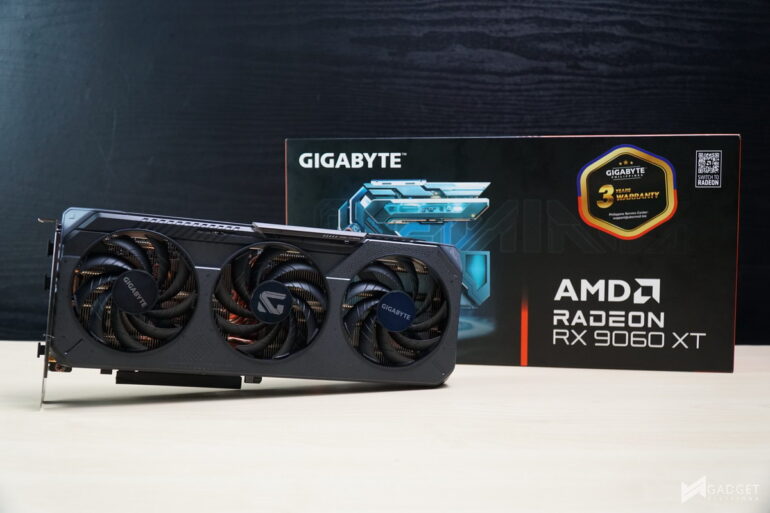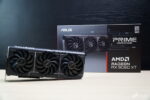Value-oriented gamers rejoice as AMD’s budget offering card, the AMD Radeon RX 9060 XT is finally on store shelves, and with that, the embargo for the RX 9060 XT models also lifts. We have the Gigabyte Radeon RX 9060 XT Gaming OC 16GB variant to compare against Nvidia’s RTX 5060 series graphics cards..
AMD RNDA 4 Architecture
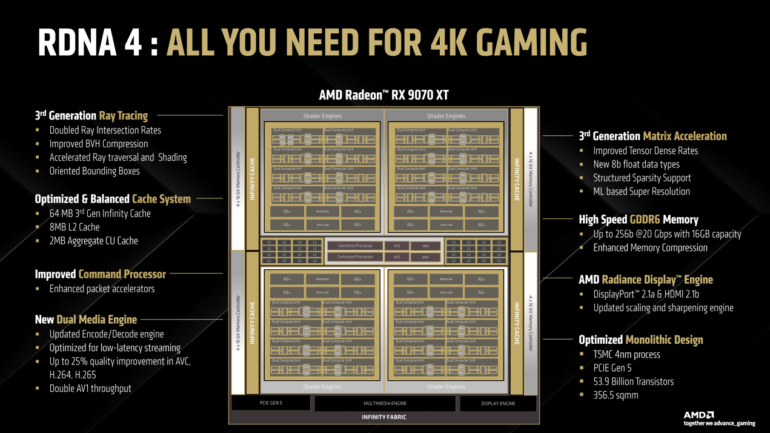
AMD’s RDNA 4 architecture is engineered for the next generation of gaming, emphasizing high-end workloads with advancements in rasterization, compute efficiency, and a substantial leap in Raytracing performance compared to RDNA 3. Key innovations include 3rd Generation Ray Tracing with double ray intersection rates, improved BVH compression, and accelerated ray traversal and shading. The introduction of Oriented Bounding Boxes (OBB) enhances efficiency by more tightly bounding geometry, reducing traversal steps, and improving performance by approximately 10%. RDNA 4 optimizes memory latency with out-of-order memory queues, allowing shaders to execute more efficiently. The architecture also features dynamic register allocation for shaders, increasing occupancy and overall shader core efficiency.

Beyond gaming, RDNA 4 provides comprehensive high-performance ML support, tailored for gaming and content creation models. It incorporates enhanced Wave Matrix Multiply Accumulate (WMMA) operations, support for 8-bit floating point formats, and 4:2 Structured Sparsity, which can double peak performance. This translates to a nearly 2x per-CU performance uplift for image generation with SDXL 1.5 using FP16. The architecture also boasts enhanced bandwidth efficiency across all workloads and multimedia improvements, including an updated encode/decode engine for low-latency streaming with up to 25% quality improvement in AVC, H.264, and H.265, and double AV1 throughput. Display features are also upgraded with enhanced FreeSync Power Optimization, Hardware Flip Queue Support, and Radeon Image Sharpening 2. The RDNA 4 is built on a TSMC 4nm process, featuring a monolithic design with 53.9 billion transistors.
FSR 4

AMD’s FSR 4 is the latest iteration of its DLSS counterpart, FidelityFX Super Resolution upscaling technology, incorporating ML-powered capabilities and designed specifically for the new RDNA 4 architecture. It aims to provide high-quality, low-latency upscaling by integrating features like frame generation and Anti-Lag. The technology utilizes custom game ML models, trained on AMD Instinct Accelerators, to upscale game output to 4K, leveraging RDNA 4’s AI acceleration capabilities. FSR 4 is “Neural Rendering Ready” and built on an upgradable FSR 3.1 API. Demonstrations suggest significant performance uplifts, with some games experiencing multiple times higher average FPS at 4K. AMD plans to support over 30 games at launch, with more than 75 titles expected in 2025.
AMD HYPR-RX
AMD HYPR-RX is a software feature designed to optimize gaming performance with a single click, integrating multiple AMD technologies for an enhanced experience across numerous titles. It combines AMD FidelityFX Super Resolution (FSR) for upscaling, AMD Radeon Anti-Lag for reducing input latency, and AMD Fluid Motion Frames (AFMF) for in-driver frame generation. Compatible with AMD Radeon RX 7000 Series GPUs and newer, as well as Ryzen 7040 Series APUs with integrated RDNA 3 graphics and later, HYPR-RX aims to deliver higher frame rates and smoother gameplay. Recent updates, particularly with AFMF 2.1, have shown substantial performance improvements, with some games demonstrating average frame rate uplifts of up to 3.0x compared to native 4K resolution.
Gigabyte RX 9060 XT Gaming OC 16GB – A Closer Look

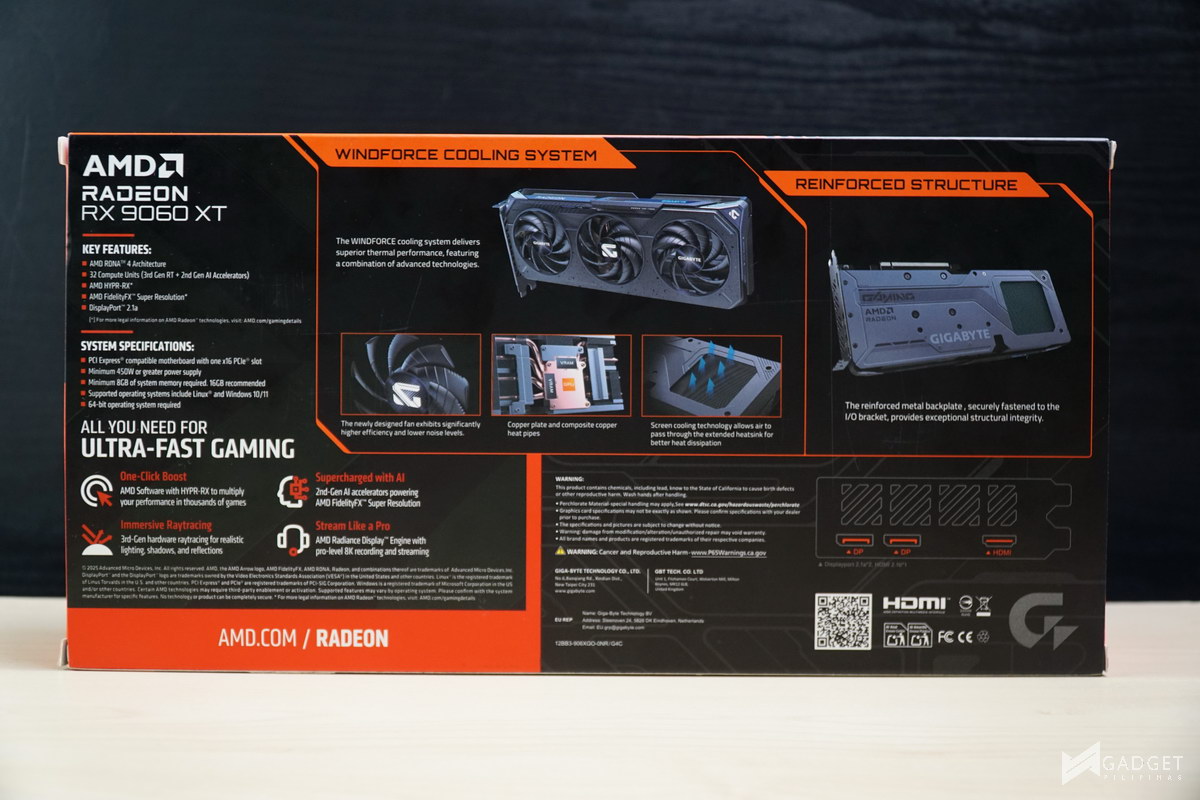
Gigabyte has a slightly different packaging design on its Radeon Gaming OC variant. Apart from the Red and orange highlights, you have the G logo positioned on the left compared to its RTX 50 series counterpart, which is positioned in the center. The back showcases the Gaming OC cooler features as well as AMD RDNA 4 architecture features.

Following the Aesthetic enhancement on the RTX 50 series, the Gigabyte Radeon RX 9060 XT Gaming OC 16G features a rough-textured black finish complemented by semi-transparent black plastic elements, and a multi-layered construction, all contributing to a premium visual appeal. This refined look positions it as a premium card in terms of aesthetics for this generation of GPUs.
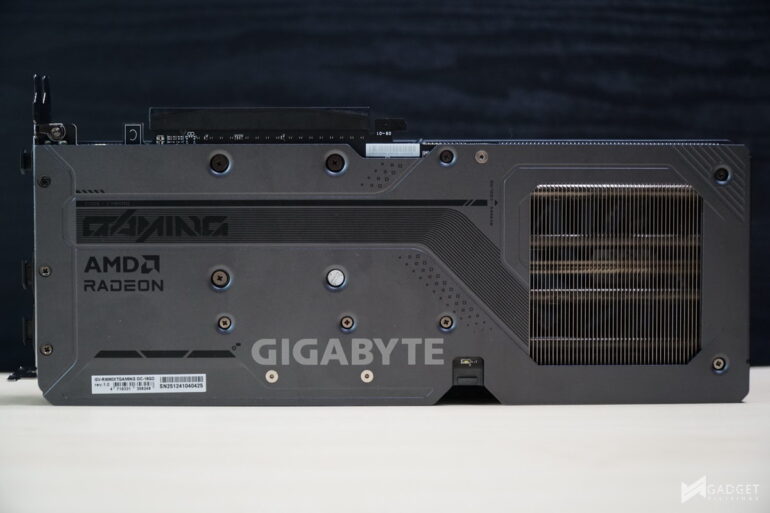
The rear of the card features a comparable multi-layered backplate with a relatively small PCB cutout that reveals about one and a half fans. This design, along with an exposed heatsink on the metal backplate, facilitates better airflow to enhance cooling performance, albeit the cutout is smaller compared to the RTX 5060 Ti Gaming OC 16G card.

The Gigabyte Radeon RX 9600 XT Gaming OC 16G measures 281 x 118 x 40mm our thinnest dual-slot, triple fan 2025 GPU so far.

The RX 9060 XT 16GB GPU has a 160W TDP with a recommended PSU of 450W. The Gigabyte RX 9060 XT Gaming OC 16GB only uses one 8pin PCI-E connector and is equipped with an LED that lights up if there’s a problem with the connector or the card’s power delivery.
Unfortunately, unlike the RTX 5060 Ti Gaming OC variant, the Gigabyte Radeon RX 9060 XT Gaming OC 16GB doesn’t have a dual-BIOS switch. It would’ve been nice to see this value-add on a much budget card but Gigabyte has decided to cut corners in this department.
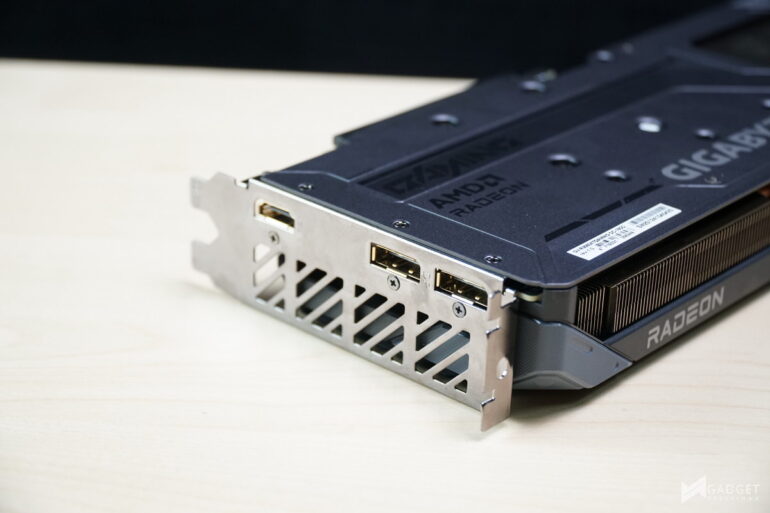
Following the disappointment of the RX 9060 XT’s IO configuration, the Gigabyte Radeon RX 9060 XT Gaming OC 16 only has two Display Port 2.1a, and one HDMI 2.1b ports – one less port compared to the industry standard.
Size Comparison vs other GPUs
Gigabyte RX 9060 XT Gaming OC 16GB vs ASUS Prime RX 9060 XT 16GB vs RTX 5070 FE vs ASUS Prime RTX 5060 vs Sapphire RX 9070 XT PURE OC
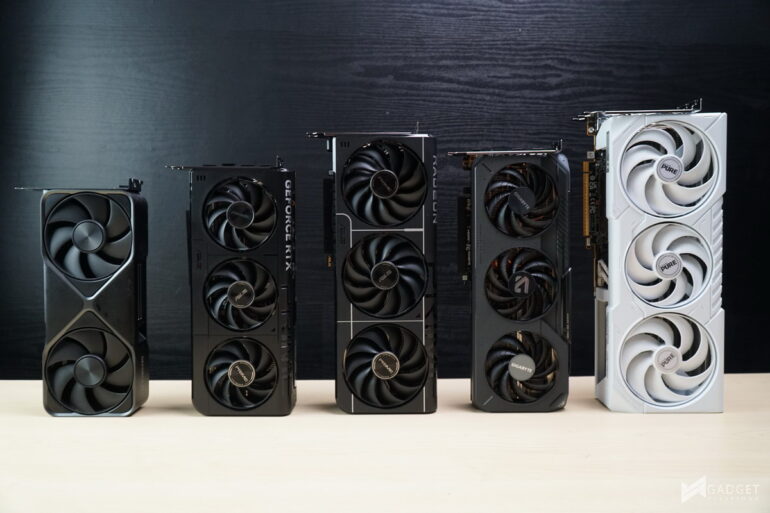
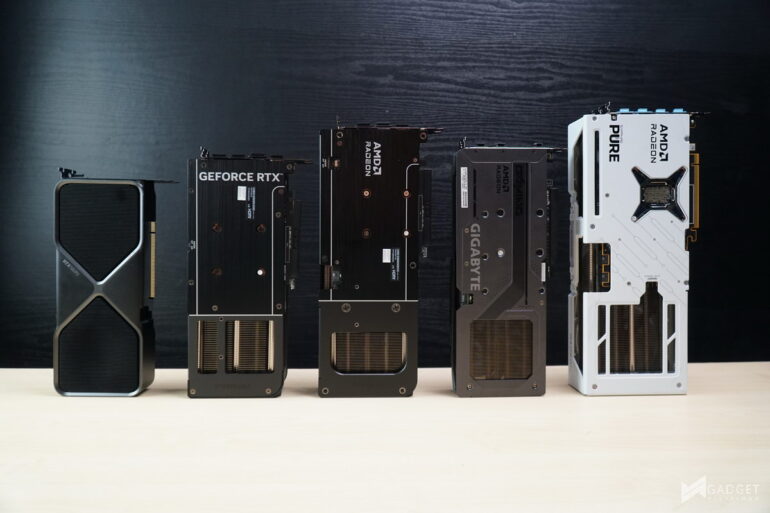

The Gigabyte Radeon RX 9060 XT is only slightly longer than our dual-slot RTX 5070 Founders Edition card and will likely have no problems fitting in most SFF cases.
Benchmark Setup and Test Methodology
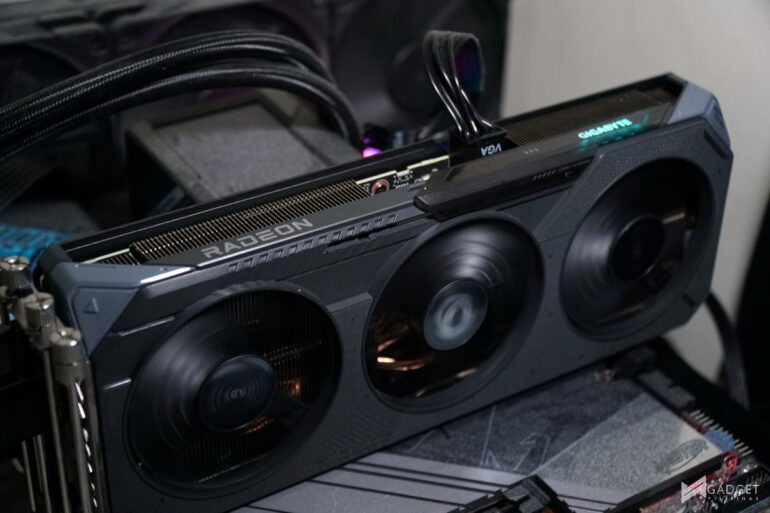
Gadget Pilipinas’ testing philosophy is to provide detail-oriented results as accurately as possible so that our readers can replicate our tests, given that these conditions are met. Different benchmarking apps and sequences are used depending on the tested component or device.
| CPU | AMD Ryzen 7 9800X3D |
| COOLER | ASUS ROG RYUJIN II 360mm V2 – Noctua NT-H2 Thermal Paste |
| MOTHERBOARD | Gigabyte X870E Aorus Master | BIOS F4i |
| MEMORY | GSkill Trident Z Neo 32GB(2x16GB) DDR5-6000 CL28 |
| GPUs | Nvidia RTX 5090 Founders Edition | Nvidia RTX 5080 Founders Edition | Inno3D RTX 5080 X3 | Nvidia RTX 4090 Founders Edition |
| STORAGE | Kingston Renegade 2TB NVME SSD |
| POWER SUPPLY | FSP VITA GM1000W Gold ATX 3.1 |
| OPERATING SYSTEM | Windows 11 Pro Build 24H2, VBS off |
| CASE | Open Benchtable V2 |
We use CapFrameX 1.7.5 BETA as our primary FPS capture and analysis tool for all our gaming benchmarks. The latest build version of Windows 11 Pro and WHQL-certified drivers are used for our benchmarks. Readings such as temperatures and power draws are recorded using HWINFO64, and other relevant software for cross-checking.
For more info, read our Review and Benchmark methodology article.
Gigabyte RX 9060 XT Gaming OC 16GB – Synthetic and Productivity Benchmarks
ADOBE PREMIERE PRO VIDEO EDITING BENCHMARK
Procyon benchmark suite is developed by UL, the same team behind 3DMark and PCMark benchmarks. The UL Procycon video editing benchmark uses Adobe Premiere in a typical video editing workflow. The benchmark starts by importing two video project files with various edits, adjustments, and effects – the second project uses several GPU-accelerated effects. Each project is exported in 1080p with H.264 encoding and again in 4K with HEVC H.265. The reported score is based on the time taken to export all four videos. GPU acceleration is turned on for GPU benchmarks.
PCMark10
From the same developers of the popular game benchmarking tool 3DMark, PCMark 10 is a benchmarking app for measuring a whole PC’s performance. It covers a wide variety of tests to reflect common tasks performed in a modern workplace. We selected PCMark 10’s extended benchmark and reported both the overall score and the Digital Content Creation Score.
V-RAY 6
V-Ray Benchmark is a stand-alone version of V-Ray developed by Chaos Group. It is designed to test the CPU and GPU by rendering sample scenes at a fixed amount of time. V-Ray is a plug-in mostly utilized by 3D computer graphics software applications mainly for industrial design, product design, architecture, film, and video game production. V-Ray is not limited to 64-threads as it supports multi and mega-threading.
GeekBench 6.3
Geekbench is a multi-platform benchmark used to gauge CPU performance and compare them across Windows, Mac, and Mobile. Geekbench 6 is the latest version and doesn’t rely on memory more than the previous Geekbench 4, making it a great tool to measure both single-core and multi-core CPU performance. Geekbench also sa GPU benchmarks using the OpenCL and Vulkan API.
BLENDER 4.3.0
Blender is a widely used, free, open-source 3D creation suite. It supports the whole 3D pipeline process from modeling, rigging, animation, simulation, rendering, and even motion tracking. Blender has become a standard for CPU benchmarks with the BMW27 and Classroom Scene most used. This prompted the company to release Blender Open Data Benchmark in 2018, a benchmark-specific version allowing users to run a preset benchmark and share the results online like 3DMark.
HANDBRAKE 1.8.2
Handbrake is a top-rated open-source video conversion software that is used by professionals, enthusiasts, and even reviewers as a reference point, mainly because of its wide variety of media codecs. The rise of streaming and blogging makes video content, both encoding and transcoding, important for these people, regardless of whether they’re seasoned professionals or just starting out. Handbrake also takes advantage of AVX-512 and OpenCL to accelerate certain types of media codecs. Our Handbrake benchmark converts a 3:16 4K60 clip shot from an S24 Ultra to 1080p60 H264 mp4 for CPU or 1080p NVENC H265 for GPU.
3DMark Benchmark Suite
3DMark is the go-to benchmark for gamers because of the ability to share and compare results online. We test GPUs both in DX11 Firestike and DX12 Timespy for the “classic” benchmarks. We also used 3DMark’s latest Steel Nomad and SpeedWay benchmarks as we slowly shift to these “more accurate” synthetic game benchmarks.
Gigabyte RX 9060 XT Gaming OC 16GB – AI Benchmarks
Geekbench AI
Computer Vision – Procyon
Image Generation – Procyon
Text Generation – Procyon
Gigabyte RX 9060 XT Gaming OC 16GB – Gaming Benchmarks
RETURNAL
Returnal is one of the most technologically advanced games since the launch of Cyberpunk 2077. Released last April 2021 on PS5 and February 2023 on PC, it uses Unreal Engine 4 and supports multiple technologies such as Ray Tracing, DLSS, VSR, and FSR.
COUNTERSTRIKE 2
CounterStrike 2 or CS2 is the successor to the now-retired CSGO and now uses the Source 2 Engine – the same engine used on DOTA 2. CS2 is a great FPS game to test out CPU performance. Our benchmark process uses the replay function of the game.
DOTA 2
Dota 2 is a good reputation among F2P titles, especially MOBAs and RTS as it lands on the demanding side of the spectrum. Its gameplay and quality of life updates are far more frequent than most F2P titles, thanks to its vast popularity. Our benchmark sequence is based on a replay of Liquid vs. Gaimin Gladiators in the The International Grand Finals Game 3 from the team fight that happened from 16:24 to 17:24.
SPIDER-MAN: MILES MORALES
Marvel’s Spider-Man: Miles Morales is developed by Insomniac Games and published by Sony, is one of the most popular PC port titles last 2022. It’s one of the few modern game titles that support upscaling technologies FSR, DLSS, and XeSS, making it a great title to use for benchmarks.
F1 23
F1 23 is the official video game of the 2023 Formula One and Formula 2 championships, developed by Codemasters. F1 2023 is the sixteenth installment in the franchise and uses the Ego Engine 4.0. F1 233 is a good representation of racing games thanks to its realistic graphics and fairly demanding spec requirements as well as support for Ray Tracing and the latest upscaling technologies such as DLSS, XeSS, and FSR.
ASSASSIN’S CREED: MIRAGE
Assassin’s Creed Mirage is the latest Assassin’s Creed game from Ubisoft making it the thirteenth major installment in the franchise. It uses the AnvilNext 2.0 game engine and is the very first AC game to support the latest upscaling technology such as XeSS, FSR, and DLSS.
Cyberpunk 2077
Cyberpunk 2077 is arguably the most hyped game of 2020. Developed by CD Projekt Red, the dystopian open-world, action-adventure RPG sports is one of the most demanding titles to date. Cyberpunk 2077 also supports three Ray Tracing settings as well as DLSS, which makes the game a great tool to measure Ray Tracing performance for both AMD and Nvidia graphics cards.
HORIZON FORBIDDEN WEST
Horizon Forbidden West is a 2022 action role-playing game developed by Guerrilla Games and published by Sony Interactive Entertainment. The Horizon Zero Dawn game sequel launched on PC last March 2024 built on the Decima Game Engine, the same one used on Death Stranding. Horizon Forbidden West features Ray Tracing and Upscaling technologies not present in the prequel game.
BLACK MYTH WUKONG
Black Myth: Wukong is one of the most popular game titles launched in 2024, with its stunning graphics thanks to the Unreal Engine 5. Developed by Game Science, Black Myth: Wukong is one of the most demanding titles recently released titles with complete Ray Tracing and Upscaling technology features, making it a great benchmark for new hardware.
GHOST OF TSUSHIMA
Ghost of Tsushima is an action-adventure game developed by Sucker Punch Productions and published by Sony Interactive Entertainment. It was initially released for the PlayStation 4 in July 2020 and later for PlayStation 5 and Windows. Ghost of Tsushima runs on a modified and optimized version of Sucker Punch’s in-house engine, originally built for the PlayStation platforms.
HOGWARTS LEGACY
Hogwarts Legacy is a popular game catering to the hearts of Harry Potter fans and gamers with its rich world and engaging gameplay. Developed by Avalanche Software and built on the Unreal Engine 4, Hogwarts Legacy delivers detailed environments and character models with support for the latest rendering and upscaling technologies.
FAR CRY 6
FarCry 6 is an FPS game published by Ubisoft that uses the Dunia engine. It heavily relies on and takes advantage of DirectX 12 to render a realistic environment that is taxing to both the CPU and GPU. It’s also the first game in the franchise to support Ray Tracing.
Gigabyte RX 9060 XT Gaming OC 16GB – Temps and Power Draw
The Gigabyte RX 9060 XT Gaming OC 16GB does marvels when it comes to cooling, as we only recorded a peak temp of 56°C with an idle temp of 34°C. Considering its size, the Gaming OC Windforce cooler is an overkill cooler for the 160W RX 9060 XT, especially that this is already an overclocked card.
Conclusion
The Gigabyte Gaming OC line is one of the most improved lineups for the RTX 50 series GPUs, and it’s much more significant when it comes to the Radeon lineup. The superb cooling performance paired with its high frame rates, compact form factor, and premium aesthetics make it a very appealing card for those looking for an above-average GPU that delivers on aesthetics, provides extra performance, without the commonly associated bulkiness of these improvements.
Priced at Php 26,590, the Gigabyte Radeon RX 9060 XT Gaming OC 16G offers a very small premium on top of the 16GB premium of the RX 9060 XT, making it one of the expensive SKUs for its class. That said, the performance, cooling, and aesthetics more than justify the premium as you’re getting a well-rounded graphics card. Its price premium is just enough that it still maintains its RX 9060 XT “budget GPU” as its pricing doesn’t overlap with the RTX 5060 Ti GPUs.
So, if you’re in the market for an OC RX 9060 XT GPU that checks all of the boxes whether your priority is aesthetics, performance, thermals, or compactness, then look no further than the Gigabyte Radeon RX 9060 XT Gaming OC 16GB graphics card- it’s currently the best value RX 9060 XT we’ve tested so far.
Grant is a Financial Management graduate from UST. His passion for gadgets and tech crossed him over in the industry where he could apply his knowledge as an enthusiast and in-depth analytic skills as a Finance Major. His passion allows him to earn at the same time help Gadget Pilipinas' readers in making smart, value-based decisions and purchases with his reviews and guides.

